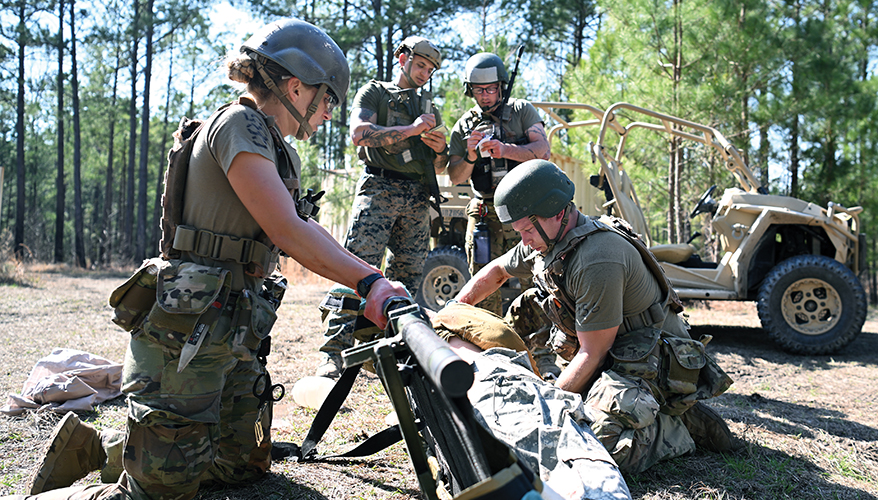DEFENSE DEPARTMENT
Context Key for Medical Trauma Training, Study Finds
By Kara Thompson
 Students in a Special Operations Combat Medic Course prepare to place a simulated patient on a litter during field training.
Students in a Special Operations Combat Medic Course prepare to place a simulated patient on a litter during field training.
Army photo
ARLINGTON, Virginia — What’s the best trauma simulation technology for military medical training? That’s a question the University of South Florida’s Center for Advanced Medical Learning and Simulation explored in a study.
The answer? It depends.
Combat medics are tasked with performing life-saving procedures in difficult situations, which is why the military uses various methods of simulations, or modalities, as part of medical training. Simulation modalities for medical training can range from cadavers, live animals and manikins to virtual reality and computer-based simulations.
“There are so many different types of simulation modalities, you have to make different considerations when choosing what is the right modality for the training that you’re trying to conduct,” Shannon Bailey, senior human factors scientist and assistant professor at the University of South Florida and lead researcher on the study, said during a Tech Grove Connect webinar hosted by the National Training and Simulation Association, an affiliate of the National Defense Industrial Association.
Special Operations Command commissioned the center to conduct the study to improve the Tactical Combat Casualty Care course, which was introduced in the 1990s by the Defense Health Agency Joint Trauma System. The resulting paper from the study, “Developing Criteria to Compare Military Medical Trauma Simulations Across Modalities,” was released in November 2023.
Despite the course leading to a significant decrease in preventable combat deaths, there is still a need to improve “efficacy and efficiency of care” to further increase survival rates, Bailey and her co-authors stated in the paper. Recent surveys show combat medics want more training opportunities before and between deployments to cut down on the “peacetime effect,” when skills decline during periods of less combat.
For the study, the center had combat medics participate in a technical experimentation event and evaluate different simulation modalities from industry developers.
The technical experimentation event lasted five days, with 33 medics evaluating 27 simulations for the 12 medical tasks being studied. A range of experienced medics attended, including active-duty personnel, reservists and retirees from the Army, Navy, Air Force and Marine Corps, Bailey said.
The study evaluated both the quantity and quality of each simulation, Bailey said. The quantity aspect looked at the degree to which a simulation could provide training for a certain task or step of a task.
“We would list out all of the task’s steps for a particular medical task and then say, ‘OK, this trainer can do 80 percent of those steps,’” Bailey said.
The medics rated each simulation based on how efficient it was in terms of training for a particular medical task and evaluated whether critical steps for each task were included and whether the simulation allowed the trainee to make an error.
“For example, if you’re doing a needle chest decompression in a virtual reality simulator and there’s only one collision area where you can place the needle in VR, if you’re not able to place it in the wrong spot, then the simulator isn’t providing the ability to mess up on a critical step,” said Bailey.
Combat medics also noted if visual, haptic or auditory information was included in the simulation. These sensory features give important cues to the medic in order to make a decision on how to treat the injury or indicate if a task was performed correctly, Bailey said.
To determine the quality of each simulation, participating combat medics gave their subjective opinions based on four criteria: acceptability of a simulation for each task; realism of different features of the simulation; reusability and deployability of the simulation; and the simulation’s ability to measure performance.
After analyzing all the data, Bailey and her team found evaluators perceived meaningful differences in the quality of different simulations, but no modality was considered uniformly superior to the others.
“Context is really important,” she said. “Military simulation training has so many different types of contexts that I think it’s more about what is the specific learning objective for a specific training” than anything else.
Next Bailey said she would like to do a study comparing haptic gloves, including what kind of feedback is necessary for various medical tasks. Other potential endeavors consist of using immersive technologies to improve distance simulations and looking at the impact of using natural language processing models to track feedback, communication and performance of a team during a medical simulation.
“We’re always open to looking at projects with different partners looking at emerging technologies in healthcare simulation and how … we get to better outcomes,” she said. ND
Topics: Defense Department
